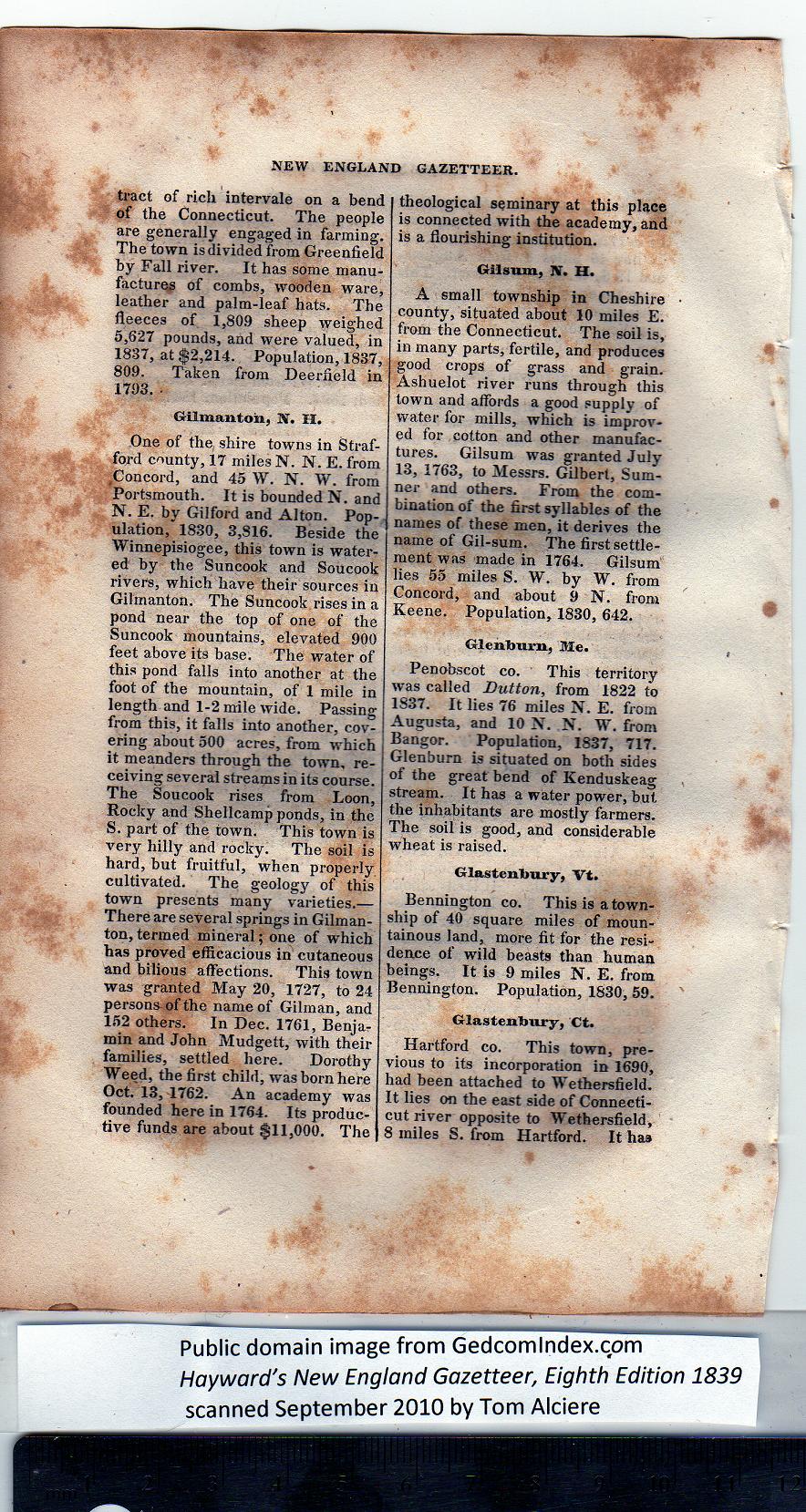|
tract of rich intervale on a bend
of the Connecticut. The people
are generally engaged in farming.
The town is divided from Greenfield
by Fall river. It has some manu-
factures of combs, wooden ware,
leather and palm-leaf hats. The
fleeces of 1,809 sheep weighed
5,627 pounds, and were valued, in
1837, at $2,214. Population, 1837,
809. Taken from Deerfield in
1793.•
Gilmantoii, IV* H.
One of the shire towns in Straf-
ford county, 17 miles N. N. E. from
.Concord, and 45 W. N. W. from
Portsmouth. It is bounded N. and
N. E. by Gilford and Alton. Pop-
ulation, 1830, 3,816. Beside the
Winnepisiogee, this town is water-
ed by the Suncook and Soucook
rivers, which have their sources in
Gilmanton. The Suncook rises in a
pond near the top of one of the
Suncook mountains, elevated 900
feet above its base. The water of
this pond falls into another at the
foot of the mountain, of 1 mile in
length and 1-2 mile wide. Passing
from this, it falls into another, cov-
ering about 500 acres, from which
it meanders through the town, re-
ceiving several streams in its course.
The Soucook rises from Loon,
Rocky and Shellcamp ponds, in the
S. part of the town. This town is
very hilly and rocky. The soil is
hard, but fruitful, when properly
cultivated. The geology of this
town presents many varieties.—
There are several springs in Gilman-
ton, termed mineral; one of which
has proved efficacious in cutaneous
and bilious affections. This town
was granted May 20, 1727, to 24
persons-of the name of Gilman, and
152 others. In Dec. 1761, Benja-
min and John Mudgett, with their
families, settled here. Dorothy
Weed, the first child, was born here
Oct. 13, 1762. An academy was
founded here in 1764. Its produc-
tive funds are about $11,000. The
theological seminary at this place
is connected with the academy, and
is a flourishing institution. |
Gilsum, N. H.
A small township in Cheshire
county, situated about 10 miles E.
from the Connecticut. The soil is,
in many parts, fertile, and produces
good crops of grass and grain.
Ashuelot river runs through this
town and affords a good supply of
water for mills, which is improv-
ed for cotton and other manufac-
tures. Gilsum was granted July
13, 1763, to Messrs. Gilbert, Sum-
ner and others. From the com-
bination of the first syllables of the
names of these men, it derives the
name of Gil-sum. The first settle-
ment was made in 1764. Gilsum
lies 55 miles S. W. by W. from
Concord, and about 9 N. from
Keene. Population, 1830, 642.
Glenburn, Me.
Penobscot co. This territory
was called Dutton, from 1822 to
1837. It lies 76 miles N. E. from
Augusta, and 10 N. N. W. from
Bangor. Population, 1837, 717.
Glenburn is situated on both sides
of the great bend of Kenduskeag
stream. It has a water power, but
the inhabitants are mostly farmers.
The soil is good, and considerable
wheat is raised.
Glastenbury, Vt.
Bennington co. This is a town-
ship of 40 square miles of moun-
tainous land, more fit for the resi-
dence of wild beasts than human
beings. It is 9 miles N. E. from
Bennington. Population, 1830, 59.
Glastenbury, Ct.
Hartford co. This town, pre-
vious to its incorporation in 1690,
had been attached to Wethersfield.
It lies on the east side of Connecti-
cut river opposite to Wethersfield,
8 miles S. from Hartford. It has |
